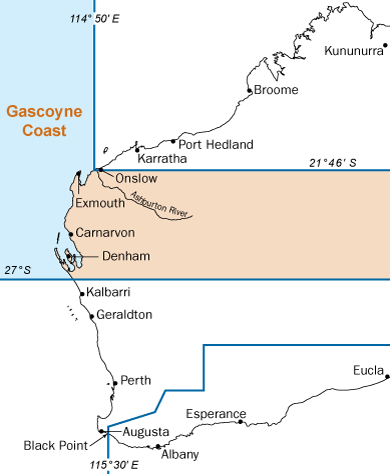
The Gascoyne Coast Bioregion runs from the Zuytdorp Cliffs, north of Kalbarri to the Ashburton River, south of Onslow (27° S to 21°46’ S).
In addition to the general fishing rules that can be found online and in our Statewide  Recreational fishing guide, please be aware of specifc rules in this bioregion covering restricted and closed areas, such as those below.
Recreational fishing guide, please be aware of specifc rules in this bioregion covering restricted and closed areas, such as those below.
Marine reserves
Marine reserves include marine nature reserves, marine parks and marine management areas. Marine parks and reserves are managed by the Department of Parks and Wildlife. However, we manage fishing inside and outside marine reserves.
Marine reserves in the Gascoyne Coast Bioregion include:
Fish Habitat Protection Areas and closed areas
Seasonal closures
Additional information is available if you are targeting specific species in the Gascoyne Coast Bioregion:
A number of species found in Western Australia waters are protected under the Fish Resource Management Act 1994 and may not be taken by either commercial, charter or recreational fishers.
Our
 Fish Identification Guide
Fish Identification Guide will help you identify your catch. Additional information is also available if you are targeting particular
species in this bioregion.
There are also specific rules for spearfishing in Ningaloo Marine Park and the Muiron Islands Marine Management Area. For more information, see  Spearfishing in Ningaloo Marine Park.
Spearfishing in Ningaloo Marine Park.
In addition, there are a number of recreational fisheries and fishing activities in the Gascoyne Coast Bioregion which require a separate licence.
Make sure you are familiar with all the rules that apply to these areas and fishing activities before you make your trip. If you are unsure about the rules or need further advice, contact your local DPIRD office.
Gascoyne Demersal Scalefish Resource
The Gascoyne Demersal Scalefish Resource is five years into a 20-year recovery plan, developed by a working group comprising Recfishwest, Marine Tourism WA, WA Fishing Industry Council and DPIRD.
The latest 2022 Gascoyne stock assessment shows oceanic pink snapper is on track to meet recovery milestones under current management measures.
Read the Science Update: key points on 2022 stock assessment.
DPIRD will engage with the working group to review the latest science against the recovery plan to provide recommendations to support the ongoing recovery of oceanic pink snapper in the Gascoyne region.
The next stock assessment to check the health of the fishery will be available in 2027.